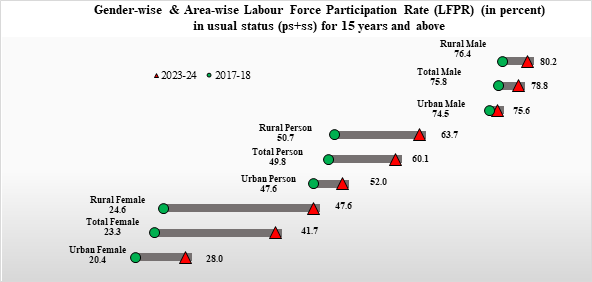he Ministry of Statistics and Programme Implementation has unveiled the 26th edition of its annual publication, “Women and Men in India 2024: Selected Indicators and Data”. This detailed report sheds light on the state of gender dynamics in India, offering a rich compendium of official statistics across critical domains such as population, education, health, economic participation, and decision-making.
Drawing from diverse government sources, the publication provides a granular, gender-disaggregated view, encompassing urban-rural divides and geographic disparities. It serves as an invaluable tool for policymakers, researchers, and stakeholders, offering insights to shape gender-sensitive strategies that drive inclusive and sustainable development.
The data reveals notable trends and challenges. At the primary and higher secondary education levels, the Gender Parity Index (GPI) has remained consistently high over the years, signaling substantial female enrollment. However, fluctuations were observed at the upper primary and elementary levels. A year-wise analysis for 2020-2024 shows slight variations in parity, with GPI values ranging from 1.07 at the primary level to 1.00 at the secondary level.
A significant improvement in labor force participation has been noted. For individuals aged 15 years and above, the Labour Force Participation Rate (LFPR) rose from 49.8 percent in 2017-18 to 60.1 percent in 2023-24. This progress is reflected across all genders and areas, with rural and urban participation highlighting key growth areas. For instance, rural women’s participation showed a dramatic rise from 24.6 percent to 47.6 percent during this period.
In financial inclusion, women account for 39.2 percent of all bank accounts and contribute 39.7 percent to total deposits, with rural regions seeing the highest female account ownership at 42.2 percent. Notably, the number of DEMAT accounts experienced a fourfold increase from 33.26 million in 2021 to 143.02 million in 2024. While men hold the majority, female participation in the stock market has shown significant growth, reflecting a positive trend.
Female entrepreneurship is on the rise, as evidenced by the increasing percentage of female-headed proprietary establishments in manufacturing, trade, and other services. The data points to a steady upward trajectory from 2021 through 2024, indicating progress in female leadership in business.
On the electoral front, India has seen a remarkable increase in voter registration, with the number of electors rising from 173.2 million in 1952 to 978 million in 2024. Female voter turnout in the 2024 elections stood at 65.8 percent, slightly below 67.2 percent in 2019, yet showcasing a narrowing gender gap. Notably, women outpaced men in voter turnout for the first time in 2024.
In the realm of entrepreneurship, the number of startups recognized by the Department for Promotion of Industry and Internal Trade (DPIIT) with at least one woman director rose from 1,943 in 2017 to 17,405 in 2024, underlining a robust trend in female-led innovation.
Overall, the publication highlights India’s strides towards gender parity while underscoring areas requiring focused interventions. This comprehensive resource is available on the Ministry of Statistics and Programme Implementation’s official website.





